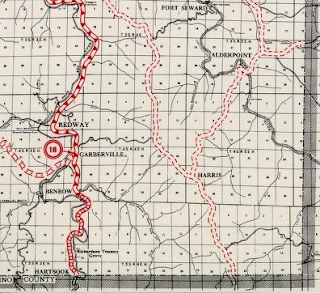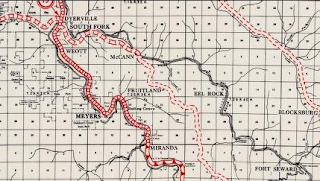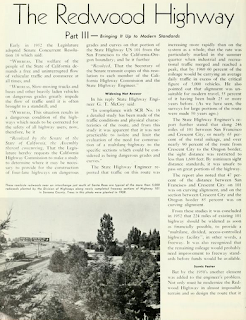The communities of Benbow, Garberville and Redway can all be found along US Route 101 within southern Humboldt County. The former surface alignment of US Route 101 in Garberville and Redway once crossed the Garberville Bluffs along what is now Redwood Drive via a corridor constructed as part of the Redwood Highway during the 1910s. US Route 101 through Benbow, Garberville and Redway was modernized by 1935. US Route 101 would eventually be upgraded to freeway standards in Benbow, Garberville and Redway by extension of the Redwood Freeway during 1966-68. As the cover photo the original grade of US Route 101 and the Redwood Highway can be seen at the Garberville Bluffs during 1934. US Route 101 can be seen in the communities of Benbow, Garberville and Redway on the 1935 Division of Highways Map of Humboldt County.
The history of what would become the Redwood Highway (later US Route 101) begins with the approval of the 1909 First State Highway Bond Act. The First State Highway Bond Act was approved by voters during 1910 and was the genesis point of some of the most notable highways in California. Legislative Route Number 1 (LRN 1) in it's original form was a new State Highway which was designated between San Francisco north to Crescent City. The route of LRN 1 would be extended to the Oregon State Line during the 1919 Third State Highway Bond Act. The planned routing of LRN 1 can be seen between Garberville of Humboldt County and Cummings of Mendocino County on the 1917 California State Automobile Association Map.
Prior to the construction of LRN 1 wagon borne traffic heading north from Cummings to Humboldt County had to ascend the treacherous Rattlesnake Grade (also known as the Bell Springs Grade). The Rattlesnake Grade is described in the July 1916 California Highway Bulletin as being only passable during the summer months. The initial north climb on the Rattlesnake Grade ascended grades as high as 20% the from Cummings to the 4,100-foot-high Bell Springs Mountain. The descent from Bell Mountain to Dyerville (now on California State Route 254/Avenue of the Giants) is described as having grades as steep as 30% amid an elevation drop of just over 3,900 feet. The construction of LRN 1 (then known as the Mendocino State Highway) sought to follow the Eel River watershed to bypass the Rattlesnake Grade. Note: The Rattlesnake Grade can be seen on the 1917 California State Automobile Association Map between Cummings and Dyerville.
Much of the Rattlesnake Grade still exists as modern Bell Springs Road. The Rattlesnake Grade can be seen in detail between Garberville-Cummings on the 1935 Division of Highways Maps of Humboldt County and Mendocino County.
The completed Redwood Highway/LRN 1 between Cummings and Garberville can be seen on the 1920 Clason Highway Map of California.
The March 1926 California Highways & Public Works featured emergency slide repairs along the Redwood Highway/LRN 1 near Garberville.
During November 1926 the US Route System was created by the American Association of State Highway Officials. US Route 101 from San Francisco north to Crescent City was aligned over the Redwood Highway. Both US 101 and the Redwood Highway between Garberville and Cummings can be seen on the 1927 Rand McNally Highway Map of California. Within Redway and Garberville US Route 101 was aligned on Redwood Drive.
The December 1929 California Highways & Public Works announced bids were received by the Division of Highways to widen US Route 101/LRN 1 from Garberville north to the outskirts of Redway at Bluff Creek to 28 feet.
The January/February 1933 California Highways & Public Works announced the widening of US Route 101/LRN 1 from Benbow 7 miles north through Garberville and Redway as being budgeted for the 1933-35 Fiscal Years. The segment of US Route 101/LRN 1 through Garberville-Redway is described as being one of the most dangerous, steep and narrow portions of the Redwood Highway.
US Route 101 can be seen passing through Benbow, Garberville and Redway on the 1935 Division of Highways Map of Humboldt County.
The March/April 1957 California Highways & Public Works discusses the modernization of US Route 101/LRN 1 in Humboldt County. The first segment of the Redwood Freeway slated to be constructed was a segment from Englewood south to the vicinity of Dyerville. Population increases in Humboldt County, traffic, and even rainfall were all cited as reasons for the expansion of US Route 101/LRN 1 via the Redwood Freeway project.
The November/December 1959 California Highways & Public Works features a report from Division Highways District I on the expansion of US Route 101/LRN 1. The "Redwood Parks Freeway" is cited to recently had a second segment completed from Myers Flat 7.5 miles north to the vicinity of Dyerville. This second segment of the Redwood Parks Freeway connected with the first completed segment which continued another 4.4 miles northward. The recently bypassed portions of US Route 101 from Myers Flat to the vicinity of Englewood were retained under State Control as a spur of LRN 1 and would form the basis for Avenue of the Giants.
The recently completed Redwood Parks Freeway can be seen on the 1960 Division of Highways State Map as US Route 101/LRN 1 north of Dyerville.
The September/October 1960 California Highways & Public Works announced that 25 miles of former US Route 101/LRN 1 north from Miranda would be maintained by the State Division of Parks and Beaches as Avenue of the Giants. Avenue of the Giants was announced on August 27, 1960, by then Governor Edmund G. Brown.
The September/October 1963 California Highways & Public Works notes that the State had formalized it's commitment to maintaining Avenue of the Giants by giving it a specific routing definition.
Avenue of the Giants is featured on the cover the November/December 1963 California Highways & Public Works.
According CAhighways.org the Legislation that added Avenue of the Giants formally to the State Highway System was Chapter 890 which was duplicated by Chapter 901. Avenue of the Giants was assigned Legislative Route Number 296 which was replaced by California State Route 254 for the 1964 Highway Renumbering. The initial definition of California State Route 254 can be seen on the 1964 Division of Highways State Map as; "Avenue of the Giants, comprising a former portion of Redwood Highway through and connecting a number of state parks, from Route 101 near the Sylvandale interchange to Route 101 near the Redcrest interchange." Notably US Route 101 can be seen with a Legislative Route Number of 254 from Phillipsville north to Myers Flat on the 1964 Division of Highways Map as the new alignment of US Route 101 had not been built yet.
The 1965 Division of Highways State Map shows US Route 101 bypassing Phillipsville and Miranda to Myers Flat. The former segment of US 101 is shown legislatively as part of Route 254.
The November/December 1965 California Highways & Public Works references freeway upgrades to US Route 101 at Sylvandale to 0.8 miles south of Garberville as being budgeted for the 1966-67 Fiscal Year.































































Comments